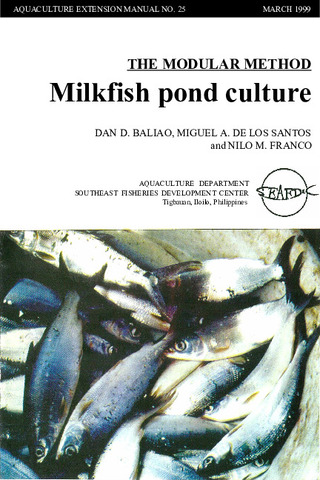Economic assessment of commercial hatchery production of milkfish (Chanos chanos Forsskal) fry
| dc.contributor.author | Garcia, Luis Maria | |
| dc.contributor.author | Agbayani, Renato F. | |
| dc.contributor.author | Duray, Marietta N. | |
| dc.contributor.author | Hilomen-Garcia, Grace V. | |
| dc.contributor.author | Emata, Arnil C. | |
| dc.contributor.author | Marte, Clarissa L. | |
| dc.date.accessioned | 2012-07-23T06:50:54Z | |
| dc.date.available | 2012-07-23T06:50:54Z | |
| dc.date.issued | 1999 | |
| dc.identifier.citation | Garcia, L. M. B., Agbayani, R. F., Duray, M. N., Hilomen-Garcia, G. V., Emata, A. C., & Marte, C. L. (1999). Economic assessment of commercial hatchery production of milkfish (Chanos chanos Forsskal) fry. Journal of Applied Ichthyology, 15(2), 70-74. | en |
| dc.identifier.issn | 0175-8659 | |
| dc.identifier.uri | http://hdl.handle.net/10862/1004 | |
| dc.description.abstract | The economic viabilities of two types of commercial hatchery milkfish (Chanos chanos) fry operations were assessed and compared. Based on the actual cost of input, the physical facilities, and the potential production yields, four commercial hatcheries previously used for shrimp (Penaeus monodon fry production were classified as either largeor smallscale operations. Cost-return analysis revealed high profits for both types of operation. The return on investment (54-61 %) and the payback period ( approximately 1.5 years) were comparable between the two types, although a large-scale operation (476 %) had double the working capital return of a small-scale hatchery (221 %). Benefit-cost analysis over a 5-year period also revealed positive and above-baseline discounted economic indicators [net current value = 0.2-2.2 million Philippine Pesos (1 US Dollar = 25 Philippine Pesos); internal rate of return = 88-107 %]. The net benefit-cost ratio of a large-scale operation (2.0) was higher than that of a small-scale hatchery (1.4), suggesting a slight edge in the investment viability of a large-scale hatchery. Compared with a large-scale operation, a small-scale hatchery was more sensitive to changes in the acquisition price of eggs or newly-hatched larvae and in the price of selling hatchery fry. Both types of operation are viable nonetheless when the acquisition cost is P6000 per million eggs or larvae and hatchery fry are sold at P0.50 each. Together, profit and investment in milkfish hatchery fry production appear viable, making milkfish an alternative commodity for production in many abandoned shrimp hatcheries. The limited availability of spawned eggs and larvae for rearing and the quality of hatchery fry are issues requiring urgent attention. | en |
| dc.language.iso | en | en |
| dc.publisher | John Wiley and Sons | en |
| dc.subject | hatcheries | en |
| dc.subject | Chanos chanos | en |
| dc.subject | Penaeus monodon | en |
| dc.subject | Philippines, Panay Island | en |
| dc.title | Economic assessment of commercial hatchery production of milkfish (Chanos chanos Forsskal) fry | en |
| dc.type | Article | en |
| dc.identifier.doi | 10.1046/j.1439-0426.1999.00094.x | |
| dc.citation.volume | 15 | |
| dc.citation.issue | 2 | |
| dc.citation.spage | 70 | |
| dc.citation.epage | 74 | |
| dc.citation.journalTitle | Journal of Applied Ichthyology | en |
| dc.subject.asfa | economic feasibility | en |
| dc.subject.scientificName | Penaeus monodon | en |
| dc.subject.scientificName | Chanos chanos |
Files in this item
| Files | Size | Format | View |
|---|---|---|---|
|
There are no files associated with this item. |
|||
This item appears in the following Collection(s)
-
Journal Articles [1256]
These papers were contributed by Department staff to various national and international journals.



